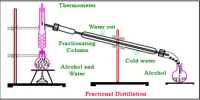In 1934, Mulliken suggested an alternative approach to electro negativity based on ionization energy and electron affinity of an atom. According to this method electro negativity could be regarded as the average of the ionization energy and electron affinity of an atom.
Electro negativity = (I.E + A.E)/2
Mulliken used ionization energy and electron affinity values measured in electron volts and values were found to be 2.8 times higher than Pauling values.
The values of ionization energy and electron affinity are measured in kJ mol-1 and 1eV =96.48 kJ mol-1.
Therefore the commonly accepted Pauling values are more nearly obtained by
Electro negativity = (I.E + A.E)/ 2*2.8*96.48 = (I.E + A.E)/540
This method has an ordinary theoretical basis and also has advantage that different values can be obtained for different oxidation states of the same element.
Disadvantage
Although Mulliken’s scale is less empirical than Pauling Scale, yet it suffers from a serious disadvantage that electron affinities with the exception of a few elements are not reliably known.












